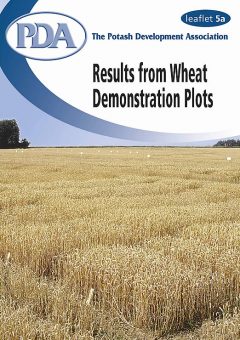5a. Results from Wheat Demonstration Plots (396.67K)
pdf 396.67K
5a. Results from Wheat Demonstration Plots
Published December 2004
Background
Crops of wheat were grown on small unreplicated plots in the Arable Area of the National Agricultural Centre, Stoneleigh. The same treatments were used on the same plots for each of the 4 years; 1987-1990. Soil was sampled in the autumn before the first harvest year and in each autumn of the comparison.
The soil is a light sandy loam with an available soil K level of 93 mg/l (index 1) at the start of the work. This K status is typical of over one third of soils in the UK.
Whilst the plots were not replicated the general conclusions from this work are clear and confirm results from fully replicated scientific experiments elsewhere.
It was not the purpose of this work to determine the optimum rate of potash to use on this site but merely to demonstrate the effect of different levels of potash fertiliser on grain yield and quality and soil fertility.
Treatments
Three potash treatments were applied to the same plots in 1987, 1988, 1989 and 1990:
| K0 nil |
K1 70 kg K2O/ha |
K2 140 kg K2O/ha |
All other inputs were identical for all three plots.
Visual differences
There were no detectable visual differences in growth habit or leaf symptoms seen in the first two years. The summer of the third year (1989) was notable for extreme drought and high temperatures and the visual differences between the K0 plot and the plots receiving potash were quite dramatic from June onwards with premature ripening. The 1990 season was also dry with quite high temperatures and the K0 plot was evident at an early stage with patchy stunted plants which failed to develop and showed marked yellowing of leaf margins and tip with early death of older leaves. By June, the K0 plot would have been described as a crop failure with premature senescence and this was reflected in yield. Little visual difference existed between the K1 and K2 plots both carrying what looked like a “reasonable” crop.
Yields
| t/ha | 1987 | 1988 | 1989 | 1990 |
| K0 | 6.1 | 6.5 | 3.8 | 2.0 |
| K1 | 6.1 | 7.0 | 7.9 | 5.6 |
| K2 | 6.1 | 7.7 | 6.9 | 5.9 |
Total potash supply to the plant was not limiting in the first year when soil K reserves fully made up for the lack of potash fertiliser on the K0 plot with no differences in yield between the three treatments.
By 1988 soil K levels on the K0 plot had been considerably depleted on this light soil and there was some indication of a potash effect on yield. This was quite a good year for wheat on this site with adequate summer moisture and modest temperatures for grain fill resulting in higher potential yields that in 1987.
Whilst 1989 was hot and very dry, the yields from the plots receiving K fertiliser did not appear to be limited by potash. The lack of potash in the K0 plot by contrast had a major limiting effect upon yield, clearly reflecting the role of potassium in the water regulations of plants. There was no obvious explanation for the considerably higher yield from the K1 plot (compared to K2) but the effect of the greater removal of K in the larger crop shows up in the reduced soil K level at the end of that season.
The need to look at potash on a long term rather than an annual basis is clearly emphasised by the yields in 1990 when the nil potash plot was virtually a crop failure giving only 2t/ha. This effect was solely due to K as all other inputs were identical. This also emphasises the importance of nutrient balance and particularly for N and K as the normal input of 175 kg/ha of nitrogen was largely wasted with N response being restricted by lack of potash and the risk of the un-utilised N leaking into the environment.
Although not measured for the whole period, grain from the K0 plot consistently had:
|
|
Soil analysis
| SOIL K mg/l (index) |
START | 1987 | 1988 | 1989 | 1990 |
| K0 | 93(1) | 48(0) | 39(0) | 32(0) | 34(0) |
| K1 | 93(1) | 71(1) | 64(1) | 31(0) | 36(0) |
| K2 | 93(1) | 81(1) | 72(1) | 57(0) | 57(0) |
The soil K figures clearly show the serious depletion of soil fertility even after the first season where no
potash was applied. Whilst visually there were no problems at this stage, the potential problem had already
been created.
It is salutary that soil K levels were slowly being reduced even where the higher rate of 140 kg/ha of fertiliser
potash was being applied to the K2 plot. This situation would need to be kept under review by regular soil
analysis.
The surprisingly large yield from the K1 plot in 1989 obviously took more potash from the soil resulting in a
large drop in soil K to 31mg/1 by the end of that season.
Conclusions
Where potash supply is limiting, yields and grain quality will be seriously affected. Nitrogen response will also be impaired with increased risk of N loss to the environment.
Potash should be treated as a long term nutrient and fertiliser use should be based on regular soil analysis and crop removal rather than apparent annual yield response or visual appearance.
Potash requirements for cereals are detailed in PDA leaflet 11 .

